Standard Microdialysis Technique
PsychoGenics offers analyses of a variety of neurotransmitters in the extracellular spaces of rodent brain via microdialysis. When combined with sensitive bioanalytical techniques, microdialysis provides the most comprehensive information on dynamic changes in the concentration of molecules involved in intercellular communication and metabolism in awake, freely moving animals. The method can be used in naïve and genetically modified animals. We have developed methods to measure acetylcholine, choline, histamine, amino acids (such as glutamate, GABA, serine and cysteine), and monoamines (dopamine, noradrenaline, serotonin and their metabolites).
Dopamine Measures
Figure 1: A ketamine dose-response study on extracellular dopamine levels in microdialysates collected from striatum of freely moving rats clearly demonstrates the impact of Ketamine on dopamine levels in the striatum.
Sprague Dawley rats, male, 250-300g, n=10/group.
Acetylcholine Measures
Figure 2: Acute vortioxetine effects on extracellular acetylcholine concentrations in the ventral hippocampus. Acute 10 mg/kg vortioxetine treatment induced a transient and relatively small, but significant increase in hippocampal extracellular Ach compared with vehicle control animals.
Alan L. Pehrson, Todd M. Hillhouse, Nasser Haddjeri, Renaud Rovera, Joseph H. Porter, Arne Mørk, Gennady Smagin, Dekun Song, David Budac, Manuel Cajina and Connie Sanchez. Task- and Treatment Length–Dependent Effects of Vortioxetine on Scopolamine-Induced Cognitive Dysfunction and Hippocampal Extracellular Acetylcholine in Rats. Journal of Pharmacology and Experimental Therapeutics September 2016, 358 (3) 472-482.




